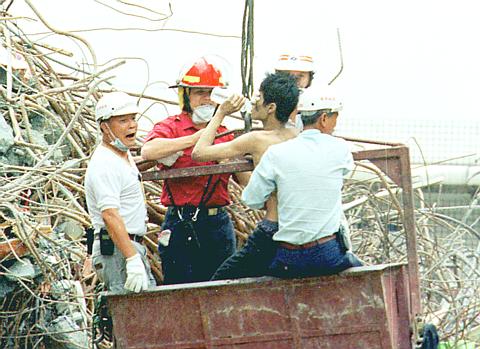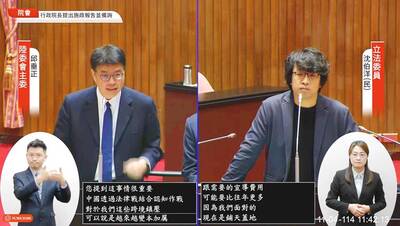For nearly 130 hours, Liu Luan (
Rescuers must have certainly thought that what they were seeing was a manifestation of divine intervention, as Sun Chi-kuang (
Sun's father, Sun Cheng (

PHOTO: YEH JEN-HAO, LIBERTY TIMES
Even Deputy Mayor Ou Chin-der (
"I was stunned for a while when I saw him. Then he shouted out that his brother was still inside. Then I asked him who he was," Ou said. "He told me he was Sun Chi-kuang, a survivor."
Sun looked in fairly good health as he flashed a smile to rescuers and his approaching relatives, before being lifted down off the rubble by a crane.
About 20 minutes later, his elder brother, Sun Chi-fong (
Mayor Ma Ying-jeou (
"He told me that he and his brother survived by eating rotten apples from a refrigerator buried with them, and by drinking mineral water and rain -- actually, it was the water we sprayed on the site through fire hoses -- as well as their own urine," Ma said.
Su Tsun-jeng (蘇忠仁), a doctor at the Armed Forces Sungshan Hospital where the brothers were sent, said that aside from smoke inhalation, dehydration and low body temperatures and blood pressure, the two were in a stable condition.
The rescue raised hopes among other relatives standing at the site that their loved ones could still be saved, and reinvigorated rescuers continued to fight against the clock, even with the specter looming of frightening aftershocks, which rocked the site yesterday.
The deputy mayor, who had been responsible for saving the lives of at least two people on the operation's first day, said the Sun brothers' survival had raised the morale of the rescue team. "We were greatly encouraged. We've always had hope. But as we saw bodies lifted from the rubble hour by hour, it was disheartening," he said.
"Now that we have seen these two men emerge from the rubble in sound health, our fatigue accumulated over the past 100 hours is gone," he said.
Ou said he had asked the younger brother to help identify his precise position in the wreckage and whether he had heard any sounds from other possible survivors still trapped in the darkness. "He said he heard the voice of an old woman, as well as the sound of how she opened a bottle of mineral water coming from a certain direction, about one or two days ago," he said.
Although doubts were obviously raised about Sun's orientation, especially in the dark, the rescue team threw its weight into pushing through the ruins in the direction Sun had pointed, in the hope of finding other survivors.
News of the recovery even prompted the Japanese team to return to the site at around 2:30pm.
But as waiting relatives moved out of an indoor resting area to sit directly opposite the wreckage, craning their necks to look for any more signs of life, they were to be disappointed as four more bodies were pulled from the ruins.
As of 10pm yesterday, the death toll at the site had reached 51, with about 50 believed to be still trapped, city officials said.
With night falling, however, no one was about to give up and rescue teams continued their toil. Anxious relatives continued to pray, hoping against the odds that the next miracle would be theirs.
Sun's mother, who later returned to the site to encourage her counterparts, brought them a message of strength: "I simply want to tell those who are still waiting that we've got to have hope."

CALL FOR SUPPORT: President William Lai called on lawmakers across party lines to ensure the livelihood of Taiwanese and that national security is protected President William Lai (賴清德) yesterday called for bipartisan support for Taiwan’s investment in self-defense capabilities at the christening and launch of two coast guard vessels at CSBC Corp, Taiwan’s (台灣國際造船) shipyard in Kaohsiung. The Taipei (台北) is the fourth and final ship of the Chiayi-class offshore patrol vessels, and the Siraya (西拉雅) is the Coast Guard Administration’s (CGA) first-ever ocean patrol vessel, the government said. The Taipei is the fourth and final ship of the Chiayi-class offshore patrol vessels with a displacement of about 4,000 tonnes, Lai said. This ship class was ordered as a result of former president Tsai Ing-wen’s (蔡英文) 2018

‘SECRETS’: While saying China would not attack during his presidency, Donald Trump declined to say how Washington would respond if Beijing were to take military action US President Donald Trump said that China would not take military action against Taiwan while he is president, as the Chinese leaders “know the consequences.” Trump made the statement during an interview on CBS’ 60 Minutes program that aired on Sunday, a few days after his meeting with Chinese President Xi Jinping (習近平) in South Korea. “He [Xi] has openly said, and his people have openly said at meetings, ‘we would never do anything while President Trump is president,’ because they know the consequences,” Trump said in the interview. However, he repeatedly declined to say exactly how Washington would respond in

WARFARE: All sectors of society should recognize, unite, and collectively resist and condemn Beijing’s cross-border suppression, MAC Minister Chiu Chui-cheng said The number of Taiwanese detained because of legal affairs by Chinese authorities has tripled this year, as Beijing intensified its intimidation and division of Taiwanese by combining lawfare and cognitive warfare, the Mainland Affairs Council (MAC) said yesterday. MAC Minister Chiu Chui-cheng (邱垂正) made the statement in response to questions by Democratic Progressive Party (DPP) Legislator Puma Shen (沈柏洋) about the government’s response to counter Chinese public opinion warfare, lawfare and psychological warfare. Shen said he is also being investigated by China for promoting “Taiwanese independence.” He was referring to a report published on Tuesday last week by China’s state-run Xinhua news agency,

‘ADDITIONAL CONDITION’: Taiwan will work with like-minded countries to protect its right to participate in next year’s meeting, the foreign ministry said The US will “continue to press China for security arrangements and protocols that safeguard all participants when attending APEC meetings in China,” a US Department of State spokesperson said yesterday, after Beijing suggested that members must adhere to its “one China principle” to participate. “The United States insists on the full and equal participation of all APEC member economies — including Taiwan — consistent with APEC’s guidelines, rules and established practice, as affirmed by China in its offer to host in 2026,” the unnamed spokesperson said in response to media queries about China putting a “one China” principle condition on Taiwan’s